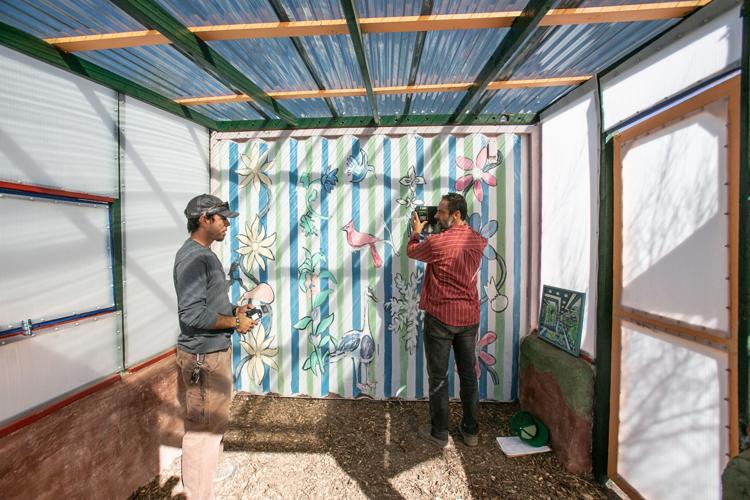Aquaponics fans like the gardening system because it is a simple, sustainable, cost-effective way to grow food.
Gardening without soil and using the excrement of fish to fertilize plants yield both protein and produce in a small amount of space.
Because water for the fish is circulated through the garden beds, the system uses less water than what a soil bed uses.
“Very little land area, water or electricity is required to operate an aquaponics system,” according to the website of aquaponics advocate and gardening store EcoGro LLC.
But the need for electricity to run a pump can be a hitch if the aquaponics system isn’t near an outlet. And it adds utility costs compared with a regular garden.
Erick Meza and Neil Saunders offer a solution: Go solar.
They will teach people how to unplug and grow plants, fish and energy in a free Dec. 1 workshop they’re calling “SolarPonics.”
It’s one of several seasonal gardening workshops offered by the Community Food Bank of Southern Arizona.
Meza is a farm education coordinator with the food bank’s Las Milpitas de Cottonwood. Saunders is a design engineer with Technicians for Sustainability, which installs solar systems.
Meza, whose background is in sustainable food production, designed and built the solar-run system in the farm’s new Youth With Roots Training Center.
He turned to solar power for the pump because it was cheaper than to run a line from electricity access that is several yards away from the greenhouse.
Materials for the greenhouse’s solar system was $3,000 and installation was free, he says. Connecting the greenhouse to the farm’s electric grid would have cost at least $5,000.
The farm also saves electricity costs by having the greenhouse stay off its grid.
Volunteer teens helped erect a 2-foot-high, U-shaped wall of pallets and rocks covered with lime plasters. It abuts a small shipping container that creates the fourth wall of the greenhouse.
Because it faces south, the greenhouse gets strong sunlight in the winter and less sun exposure during the hottest part of summer days.
The plaster wall is topped with bright white, insulated greenhouse panels. It’s made to diffuse sunlight, making the interior 25 percent brighter than what shines outside. The roof also is made of greenhouse panels.
A door provides access to the aquaponics system, which is 5 feet wide and 10 feet long.
One tank is filled with water to grow goldfish and koi, which Meza says poop a lot, as well as tilapia in season. The tilapia will be harvested for food.
In a stair-step design, one garden bed is lower than the tank and one is higher. The pump moves water fertilized by fish excrement to the garden beds. The plants take up the nutrients provided by the fish.
The cleaner water and oxygen from circulation go back to the fish tank.
The system was filled with water harvested from rain. City water will be used to make up for evaporation.
The pump, which moves 250 gallons of water an hour, is powered by the solar panels atop the shipping container. The panels can generate 700 watts of power. A backup battery stores electricity that’s held in reserve until it’s needed to run the pump, usually at night.
The solar system also runs a small swamp cooler that Meza is using to grow mushrooms inside the shipping container.
Both Meza and Saunders admit this greenhouse is probably a bit fancier than what your average home aquaponics gardener will have.
Indeed, Brendan Woltman, owner of EcoGro, says most aquaponics systems that his customers build and run wouldn’t get a return on their solar-system investment for 10 to 15 years.
“People don’t want to invest in battery backups,” says Woltman.
Saunders maintains that it’s good to know how to use solar systems to grow plants for when the world may not have an electrical grid to tap into.
“What are you going to do when you burn up all the oil?” he muses.
The SolarPonics course will talk about solar-powered greenhouses of all sizes and complexities. Some home set-ups need electricity for fans and automatic misters, for instance.
But Saunders also wants to talk about how to be a better consumer of electricity.
“I’ll be looking at efficiencies,” he says. Equipment that uses less electricity and greenhouses that make better use of sunlight all contribute to sustainable gardens and reduce the cost of installing solar systems.
Even Meza acknowledges that the solar-powered greenhouse he’s designed may need adjustments as the system goes into full production.
“It’s a bit of an experiment,” he says. “Our main goal is to prove it works. It would be easy to duplicate.”







